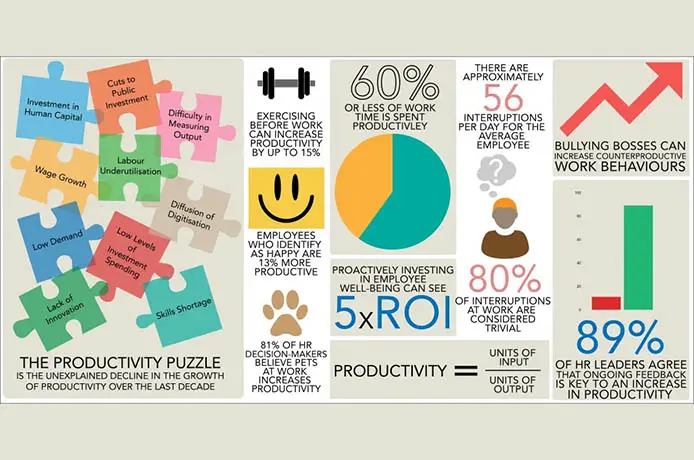Macro: The Productivity Puzzle
Productivity is an economic term that refers to the measurement of output per unit of input. In the UK productivity has been measured in order to better understand labour behaviours. Post-World War Two, productivity increased by over 2% annually, and between 2000 and 2007 the UK productivity rate increased at 2.64% p.a. (Goodridge, et al., 2016). However, following the 2008/09 recession, productivity dropped to 0.7% per annum. That is, the rate of increase in the amount produced per hour of work has decreased by two-thirds (Arnold, & Stirling, 2019). In short, the UK’s productivity rate has flat-lined, and this stagnation has come to be referred to as the Productivity Puzzle.
There is a multitude of potential explanations and theories for this, such as a fall in demand, wage growth stagnation, slow diffusion of digitisation, emerging skills shortage, ageing population, cuts to public investments, and even difficulty in measuring output in some service industries. However, as the tag ‘Productivity Puzzle’ suggests, there is a general lack of consensus on the cause of this unprecedented and unusual stagnation. While at its worst in the UK, it is also present in most advanced economies, including most of Western Europe, the United States, as well as Australia.
The Australian Government Productivity Commission 2020 Report acknowledges the same dynamic is evident here in Australia. “Although there are many theories for why productivity growth has slowed, there is little consensus in the economics profession.” Like the UK, Australia reported a higher current productivity rate of 1.4 % per annum post the 2008-09 recession. This is primarily due to productivity in our mining sector (Lowe, 2018). Yet, this is still dramatically below the 2.4% productivity growth average seen from 1995-2004. RBA Governor Dr Phillip Lowe argues that while Australia may currently have a better productivity rate than other nations, we may see a downturn if we continue failing to invest enough capital. The financial year 2017-18 saw a productivity increase of only 0.2% (Australian Government Productivity Commission, 2019). He has implored governments and businesses to focus on reforms that lift productivity to improve the economy’s growth potential. In particular, he recommends a strong ongoing focus on training, education and the accumulation of human capital (Lowe, 2018).
Micro: How do we look after our human capital?
New Economics Foundation founder Nic Marks, argues that proactively investing in well-being can see five times return on investment over the ensuing year (Marks, 2020). Well-being can increase productivity, creativity, engagement, and innovation.
Only 60% or less of work time is actually spent productively (Atlassian, n.d.). Workplace productivity can be impacted by a multitude of different factors, such as exercise, stress, engagement, ineffective meetings, emails and interruptions. 47% of employees who feel anxious about their personal finances acknowledge a decrease in productivity and an increase in absenteeism. They are also nearly five times more likely to be distracted at work. And are twice as likely to spend three or more hours a week at work dealing with their financial matters (PWC, 2017). Additional stress from bullying bosses can also increase counterproductive work behaviours, such as coming in late, taking extended breaks, completing tasks incorrectly, or reducing effort (Pedersen, 2019).
Implementing a strong work culture, communication and collaboration can increase productivity by up to 25% (McKinsey, 2012). 89% of HR leaders agree that ongoing feedback is critical for successful outcomes, as people need to be reminded that what they are doing has purpose or meaning, leading to a positive sense of well-being and subsequent increase in productivity (SHRM/Globoforce, 2018). Employers who identify as being happy are 13% more productive (Oxford University, 2019). 81% of HR decision-makers believe allowing pets in the workplace increases productivity (Banfield Pet Hospital, 2016). And, according to the American Psychological Association, you can gain a 15% productivity boost if you exercise before work (APA, 2012).
Atlassian. (n.d.). You Waste A Lot of Time At Work. Retrieved from: https://www.atlassian.com/time-wasting-at-work-infographic
Australian Government Productivity Commission. (2019). PC Productivity Bulletin. Retrieved from https://www.pc.gov.au/research/ongoing/productivity-insights/2019/productivity-bulletin-2019.pdf
Australian Government Productivity Commission. (2020). PC Productivity Insights: Recent Productivity Trends (Report No. 1/2020). Retrieved from https://www.pc.gov.au/research/ongoing/productivity-insights/recent-productivity-trends/productivity-insights-2020-productivity-trends.pdf
Goodridge, P., Haskel, J. and Wallis, G. (2018), Accounting for the UK Productivity Puzzle: A Decomposition and Predictions. Economica>, 85: 581-605. doi:10.1111/ecca.12219
Lowe, P. (2018). Productivity, Wages and Prosperity. Retrieved from the Reserve Bank of Australia website: https://www.rba.gov.au/speeches/2018/sp-gov-2018-06-13.html
Marls, N. (2020). How investing in well-being give 5x ROI. Retrieved from Nic Marks website: https://nicmarks.org/how-investing-in-wellbeing-gives-a-5x-roi/
McKinsey Global Institute. (2018). Solving the Productivity Puzzle: The Role of Demand and the Promise of Digitization. Retrieved from https://www.mckinsey.com/~/media/mckinsey/featured%20insights/meeting%20societys%20expectations/solving%20the%20productivity%20puzzle/mg-solving-the-productivity-puzzle–report-february-2018.ashx
Oxford University. (2019, October 25). Happy workers are 13% more productive. Phys.org. Retrieved from https://phys.org/news/2019-10-happy-workers-productive.html
Pedersen, T. (2019, March 8). How Abusive Bosses Reduce Workplace Productivity. Psych Central. Retrieved from https://psychcentral.com/news/2019/03/08/how-abusive-bosses-reduce-workplace-productivity/143525.html
PWC. (2017). Special Report: Financial Stress and the Bottom Line. Retrieved from https://www.pwc.com/us/en/private-company-services/publications/assets/pwc-financial-stress-and-bottom-line.pd
SHRM/Globoforce. (2018). Employee Recognition Report: Designing Work Cultures for the Human Era. Retrieved from http://go.globoforce.com/rs/862-JIQ-698/images/SHRM2017_GloboforceEmployeeRecognitionReportFinal.pdf?_ga=2.25945533.1049670599.1590476048-55994556.1590476048
Stirling, A., & Arnold, S. (2019, April 22). Tackling the Productivity Puzzle: A Higher Minimum Wage and a 4-Day Week [Blog Post]. Retrieved from https://neweconomics.org/2019/04/tackling-the-productivity-puzzle







